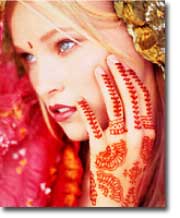The Tilaka is normally a vermilion mark applied on the forehead.
This mark has a religious significance and is a visible sign of
a person as belonging to the Hindu religion. The Tilaka is of more
than one colour although normally it is vermilion. It also does
not have any standard shape and form and is applied differently
by members of different Hindu sects and sub-sects.
It is applied as a 'U' by worshippers of lord Vishnu and is red,
yellow or saffron in colour It is made up of red ochre powder (Sindhura)
and sandalwood paste (Gandha). Worshippers of lord Shiva apply it
as three horizontal lines and it consists of ash (Bhasma). Soot
(Abhira) is also used as a pigment for applying a Tilaka.
Thus there is a variety of pigments; red, yellow, saffron, white, grey and black, etc. These pigments are not only applied on the forehead but in some cases they are applied also on the forearms and the abdomen. This is normally so in the case of worshippers of Shiva, a deity whose origin is said to lie in the primitive pre-Arvan or proto-Aryan society.
Literally, Tilaka means a mark. Sindhura which is also used to describe a Tilaka means red and Gandha which is also a term for Tilaka means pleasant odour. Hence, Tilaka normally connotes, a red mark with a pleasant odour. Some scholars have seen the red colour as a symbolism for blood. We are told that in ancient times, in Aryan society, a groom used to apply his blood, on-his bride's forehead as a recognition of wedlock. The existing practice among Indian women of applying a round shaped red Tilaka called Bindiya or Kumkum could be a survival of this.
Significantly when an Indian woman has the misfortune of becoming a widow she has to stop wearing this mark. In a woman's case a Tilaka is a sign of her being in wedlock Among men, the Tilaka has been traditionally interpreted as a good luck charm. Apart from applying it in the course of normal life, its application had special significance while setting out for a battle, a hunt or before any other event of importance. To demonstrate the person's solemn commitment to succeed in the endeavour he was about to undertake, the Tilaka was made up of the person's own blood. Even today application of one's own blood as a Tilaka is considered to be a display of solemn commitment to the oath or pledge being undertaken.How this practice of Tilaka came into being is an open question. But anthropological researches show that in most tribal societies in tropical and equatorial regions, there exist customs according to which people paint their naked or semi-nude bodies with different pigments. This may be for decorative and ritualistic reasons. Even today in our civilised way of life, during festivals like Holi or Carnival whose origins are supposed to lie in a primitive tribal past, the smearing of colours is an essential aspect of festivities. Tilaka could be a refined adaptation of this tribal practice.
On the whole it can be said that Tilaka is a survival of the tribal practice of smearing one's body with different colours. This practice was later refined and given a solemn meaning.

![]()



